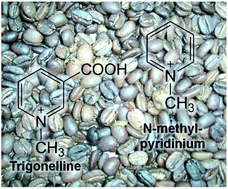N-Methylpyridinium, a degradation product of trigonelline upon coffee roasting, stimulates respiratory activity and promotes glucose utilization in HepG2 cells
Abstract
N-Methylpyridinium (NMP) is a thermal degradation product of trigonelline formed upon coffee roasting and hypothesized to exert several health benefits in humans. Since for trigonelline evidence for hypoglycemic effects exists, we examined whether NMP also affects mechanisms of glucose utilization and cellular energy formation. For this purpose, the impact of trigonelline and NMP on respiratory activity, extracellular acidification, cellular adenosine nucleotides, energy supply from fatty acids and glucose as well as thermogenesis in HepG2 cells was analyzed. A 24 hour incubation with nanomolar concentrations of NMP enhanced oxygen consumption rates, resulting in increased ATP levels. Glucose was identified as the prevalent energy substrate as its uptake was augmented up to 18.1% ± 7.44% by NMP at 0.09 μM, whereas the uptake of fatty acids decreased upon NMP treatment. Cellular glucose uptake was also stimulated by trigonelline administration; however, a shift to the anaerobic energy production pathway was monitored. Both pyridine derivatives induced thermogenesis, although trigonelline presumably promoted proton leaks, while NMP increased the concentration of the uncoupling protein-2. We provide evidence that both compounds appear to stimulate cellular energy metabolism in HepG2 cells. Human intervention studies are warranted to ensure these effects in vivo.


 Please wait while we load your content...
Please wait while we load your content...